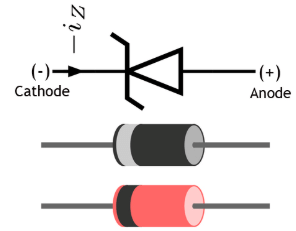Theory & Procedure, Zener Diode | Physics Class 12 PDF Download
Our Objective:
To draw the reverse characteristic curve of a Zener diode and to find its reverse breakdown voltage.
The Theory:
Zener diode
A Zener diode is a heavily doped silicon crystal diode which allows current to flow in the forward direction in the same manner as an ideal diode. It also permits the current to flow in the reverse direction when the voltage is above a certain value known as the breakdown voltage. Breakdown voltage is also known as Zener knee voltage.
The device was named after an American Physicist, Clarence Zener, who described the property concerning the breakdown of electrical insulators.
The device consists of a reverse biased, highly doped, p-n junction diode operating in the breakdown region. Conventional diodes and rectifiers never operate in the breakdown region, but the Zener diode can safely be operated at this point.
 Working of Zener diode
Working of Zener diode
As the reverse voltage applied to the Zener diode increases, it reaches the breakdown voltage at which Zener current increases to a large value. In the breakdown region, further increase in reverse voltage will not increase the voltage across the Zener diode, it only increases the current. Thus, a constant voltage called Zener voltage (Vz) is maintained across the Zener diode when the supply voltage changes. Hence, it acts as a voltage regulator.
The reverse characteristic is obtained by taking reverse voltage along – ve X-axis and reverse current along –ve Y-axis. As the reverse voltage reaches a certain value, the reverse current increases to a large value, but the voltage across the diode remains a constant. This is the break down voltage Vz.

Learning Outcomes:
- Students understand the terms Zener diode, breakdown voltage, etc.
- Students are able to do the experiment in the real laboratory, once they understand the procedure.
Materials required:
- Battery
- Rheostat
- Small resistance (200 Ω)
- Milliammeter
- Voltmeter
- Key
- Zener diode
Real Lab Procedure:
- Connections are made as shown in the circuit diagram.

- By adjusting the rheostat, voltmeter reading is increased from 0 and in each time note the corresponding reading in milliammeter.
- The experiment is continued till the milliammeter shows a large deflection while the voltmeter reading remains a constant, indicating the break down voltage.
- Plot the reverse characteristic curve by taking reverse voltage along –ve X-axis and reverse current along –ve Y-axis.
- The break down voltage Vz is obtained from the graph as shown below.
Simulator Procedure:
- Select the Zener diode from the drop down list.
- To see the circuit diagram, click on the 'Show/hide circuit diagram' check box seen inside the simulator window.
- Connections can be made as seen in the circuit diagram by clicking and dragging the mouse from one connecting terminal to the other connecting terminal of the devices to be connected.
- Drag the key to insert it.
- You can change the rheostat resistance using the slider.
- You can notice the corresponding ammeter and voltmeter readings.
- You can use the embedded worksheet to enter the values.
- To see the graph, click on the graph icon in the worksheet.
- To redo the experiment, click on the ‘Reset’ button.
Observations:
Least count of voltmeter = ...........V
Zero error of voltmeter = ............V
Least count of milli-ammeter = ...........mA
Zero error of milli-ammeter = ...........mA
Trial No. | Reverse Voltage (V) | Reverse Current (mA) |
1 | ||
2 | ||
3 | ||
4 | ||
5 | ||
6 | ||
7 | ||
8 | ||
9 | ||
10 |
Calculation:
Plot the reverse characteristic curve by taking reverse voltage along –ve X-axis and reverse current along –ve Y-axis.
Result:
- The reverse characteristic curve of the Zener diode is obtained.
- The reverse breakdown voltage of the Zener diode, V = ………….V
|
127 videos|452 docs|99 tests
|
FAQs on Theory & Procedure, Zener Diode - Physics Class 12
| 1. What is a Zener diode? |  |
| 2. What is the purpose of a Zener diode? |  |
| 3. How does a Zener diode work? |  |
| 4. What are the applications of Zener diodes? |  |
| 5. How can I select the right Zener diode for my circuit? |  |






















